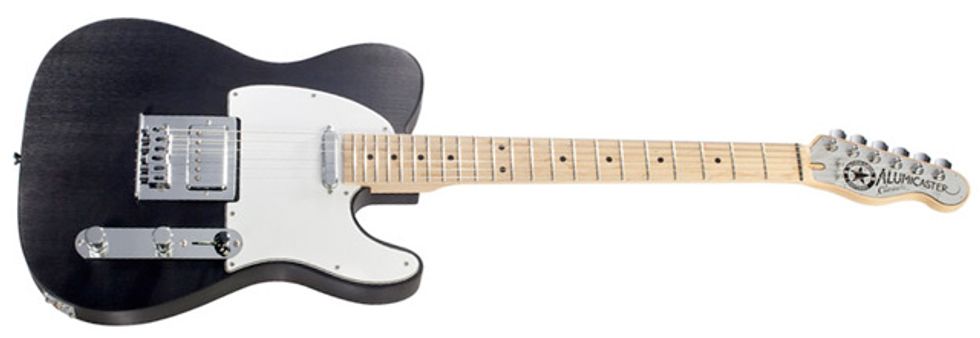| Download Example 1 Bridge, clean | |
| Download Example 2 Bridge, crunch | |
| Download Example 3 Neck, clean | |
| Download Example 4 Neck, crunch | |
| Download Example 5 Both, clean | |
| Download Example 6 Both, crunch | |
| All clips recorded through a 1965 Fender Princeton Reverb with EQ set at 5, SM57 on speaker and Rode NT-1 in room. | |
I am a Tele guy through and through, and I'm pretty traditional when it comes to my definition of a Telecaster. I must confess that I was initially very skeptical when I found out I would be reviewing an aluminum Telecaster. However, I quickly realized that the Alumicaster differs from a traditional Tele in more ways than just materials—from the playability to the tones, this instrument goes beyond the shape it embodies.
First Impressions
The Alumicaster is shaped like a Telecaster, with a slightly oversized headstock and wide-looking maple neck with maple fingerboard. The headstock design reminds me of a sneaker logo. The body is anodized Obsidian black, with grain pattern designed to give the material more character. Visually, it’s hard to tell off the bat that the guitar isn’t wood. Normandy also offers chrome and custom finishes with laser engraving [Normandy also sent a custom aged copper finish Alumicaster with rosewood fingerboard].
Taking the guitar out of the case, I missed the feeling of a wood body—for me, the feeling of cold metal wasn’t very inspiring. I immediately noticed that the guitar’s hollow body makes it very neck-heavy, like an SG. The nut is cut to 1 11/16” with a C profile neck and a 12” radius. I found the neck to be too wide for my liking, but that’s a personal preference. The scale length is 25 1/2” and the neck meets the body at the 17th fret. The guitar is stocked with a Seymour Duncan Custom-Custom humbucker in the bridge and a Duncan "Hot Tele" pickup in the neck.
The guitar comes with a nice setup, which is refreshing, and it feels easy to play. The intonation is dead-on all over the neck. As I checked the intonation unplugged, I realized I had a hard time finding any dead spots—everywhere I played it rang like a tuning fork, more like a 335 than a Tele. The Gotoh tuners are great and there are two string trees on the headstock, which is good because this thing really resonates (likely due to the aluminum blocks at the bridge and neck joint). However, the string trees are also really close to the nut, which might trip up some players who rely on behind-the-nut bends.
Plugging In
I plugged the Alumicaster into my 1965 Princeton Deluxe Reverb, which is, in my opinion, the Telecaster's soul mate. I was pleasantly surprised—it didn’t sound like a Tele, but it sounded beautiful. The Alumicaster is a really chimey, full-sounding instrument with huge sustain.
The humbucker in the bridge is twangy but not anemic. It has tons of bite backed by a hollow-body sound. The neck pickup on its own—a weak spot for many Teles—is a little muddy, but the two pickups combined are worth it. With both pickups engaged, the guitar can sound like a big jazz box. I couldn’t help but wonder how the guitar would’ve sounded with a Tele bridge pickup and humbucker in the neck. Luckily, Normandy offers a variety of pickup configurations for those looking for something different.
The controls are laid out like a traditional Tele: three-way switch, Tone, and Volume. The Tone and Volume pots are not an even sweep—both open really quickly. For the Tone knob, this means that pulling off Gatton-esque tone sweeps is a breeze. I dug it. For the Volume, getting beautiful even swells are not really possible. I was pleasantly surprised at the guitar’s performance at higher volumes. Despite the guitar’s great resonance, the clarity and definition aren’t lost when the amp is cranked. In fact, the tone became really punchy, like a Les Paul Junior.
The Verdict
Normandy made me a believer in aluminum—this is in a class of its own. The guitar is not a one trick pony. Because of the sustain, the Alumicaster makes a great lead guitar, but I think its biggest strength is as a rhythm guitar. The acoustic qualities, clarity when strumming, and punchiness when cranked make it perfect sitting in any mix. I could absolutely see this being anyone’s main axe. There are some issues I’d like to see addressed before spending a couple grand on one—string trees better positioned for bending, a more even volume pot, and better balance between the body and neck—but if you got the cash, they're a pretty damn unique voice to have in the toolbox. I can't wait to see how Jim Normandy’s guitars evolve over the next 10 years.
Buy if...
you're looking for something truly different with a huge tonal palette.
Skip if...
you're looking for a something affordable with a tradition Tele sound.
Rating...
Street $1949 - Normandy Guitars - normandyguitars.com |







![Rig Rundown: Russian Circles’ Mike Sullivan [2025]](https://www.premierguitar.com/media-library/youtube.jpg?id=62303631&width=1245&height=700&quality=70&coordinates=0%2C0%2C0%2C0)

















